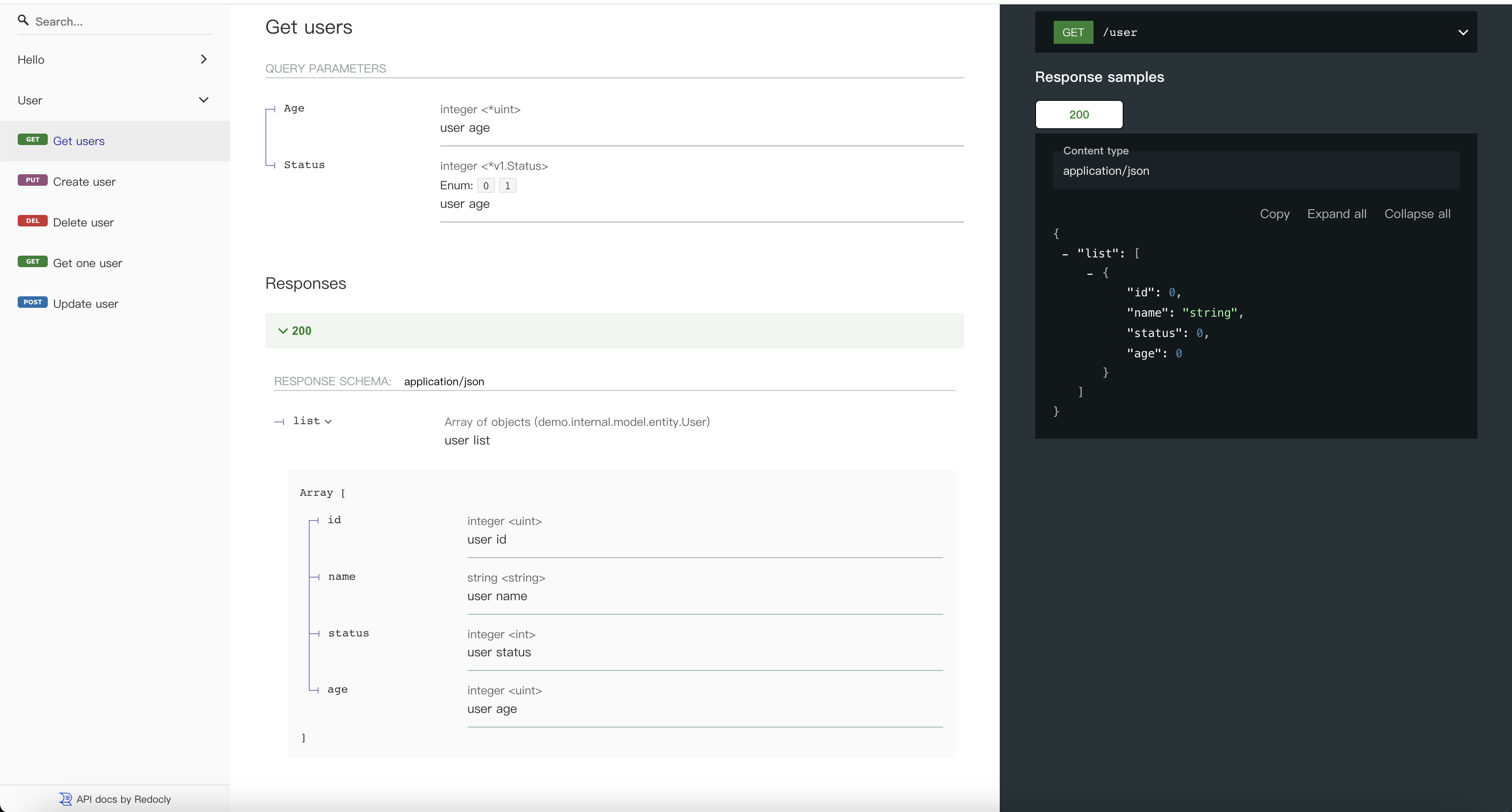Start the Service
We can use the command line or the IDE's built-in start tool to start the service. To simplify the example, we directly use go run main.go in the command line to start our service:
$ go run main.go
2024-11-16 16:40:07.394 [INFO] pid[39511]: http server started listening on [:8000]
2024-11-16 16:40:07.394 [INFO] {18594fad2e66081870e88c6e1440060b} swagger ui is serving at address: http://127.0.0.1:8000/swagger/
2024-11-16 16:40:07.394 [INFO] {18594fad2e66081870e88c6e1440060b} openapi specification is serving at address: http://127.0.0.1:8000/api.json
ADDRESS | METHOD | ROUTE | HANDLER | MIDDLEWARE
----------|--------|------------|-------------------------------------------------------|----------------------------------
:8000 | ALL | /api.json | github.com/gogf/gf/v2/net/ghttp.(*Server).openapiSpec |
----------|--------|------------|-------------------------------------------------------|----------------------------------
:8000 | GET | /hello | demo/internal/controller/hello.(*ControllerV1).Hello | ghttp.MiddlewareHandlerResponse
----------|--------|------------|-------------------------------------------------------|----------------------------------
:8000 | ALL | /swagger/* | github.com/gogf/gf/v2/net/ghttp.(*Server).swaggerUI | HOOK_BEFORE_SERVE
----------|--------|------------|-------------------------------------------------------|----------------------------------
:8000 | GET | /user | demo/internal/controller/user.(*ControllerV1).GetList | ghttp.MiddlewareHandlerResponse
----------|--------|------------|-------------------------------------------------------|----------------------------------
:8000 | POST | /user | demo/internal/controller/user.(*ControllerV1).Create | ghttp.MiddlewareHandlerResponse
----------|--------|------------|-------------------------------------------------------|----------------------------------
:8000 | DELETE | /user/{id} | demo/internal/controller/user.(*ControllerV1).Delete | ghttp.MiddlewareHandlerResponse
----------|--------|------------|-------------------------------------------------------|----------------------------------
:8000 | GET | /user/{id} | demo/internal/controller/user.(*ControllerV1).GetOne | ghttp.MiddlewareHandlerResponse
----------|--------|------------|-------------------------------------------------------|----------------------------------
:8000 | PUT | /user/{id} | demo/internal/controller/user.(*ControllerV1).Update | ghttp.MiddlewareHandlerResponse
----------|--------|------------|-------------------------------------------------------|----------------------------------
As we can see, the CRUD APIs we developed have been successfully registered on the Web Server and displayed correctly on the terminal. Meanwhile, we have enabled the API documentation feature, so let's look at the auto-generated API documentation.
API Documentation
According to the address printed in the terminal, we visit: http://127.0.0.1:8000/swagger/

Automated API documentation generation is one of the very powerful features provided by the GoFrame framework. We won't go into detail here, but those interested can refer to the section: API Document
API Testing
To simplify testing operations, we use the curl command for testing and submit and receive return parameters in json format.
The $ symbol at the front of the execution commands below represents the terminal command line tool's prompt and is not a part of the command we enter. Different terminal command lines have different prompt symbols.
Create
A creation request needs to be submitted using the POST method.
$ curl -X POST 'http://127.0.0.1:8000/user' -d '{"name":"john","age":20}'
{"code":0,"message":"","data":{"id":1}}
$ curl -X POST 'http://127.0.0.1:8000/user' -d '{"name":"alice","age":18}'
{"code":0,"message":"","data":{"id":2}}
The returned code of 0 indicates that the execution was successful.
Let's construct requests that do not meet the validation rules and see the effect:
$ curl -X POST 'http://127.0.0.1:8000/user' -d '{"name":"smith","age":16}'
{"code":51,"message":"The Age value `16` must be between 18 and 200","data":null}
$ curl -X POST 'http://127.0.0.1:8000/user' -d '{"name":"sm","age":18}'
{"code":51,"message":"The Name value `sm` length must be between 3 and 10","data":null}
As we can see, the validation rules have taken effect and returned specific validation error messages. The error code 51 is a built-in error code in the framework, indicating a validation error. Developers can also customize error codes. For more information on error codes, please refer to the relevant sections of the developer's manual.
GetOne
$ curl -X GET 'http://127.0.0.1:8000/user/1'
{"code":0,"message":"","data":{"id":1,"name":"john","status":0,"age":20}}
$ curl -X GET 'http://127.0.0.1:8000/user/2'
{"code":0,"message":"","data":{"id":2,"name":"alice","status":0,"age":18}}
GetList
$ curl -X GET 'http://127.0.0.1:8000/user'
{"code":0,"message":"","data":{"list":[{"id":1,"name":"john","status":0,"age":20},{"id":2,"name":"alice","status":0,"age":18}]}}
$ curl -X GET 'http://127.0.0.1:8000/user?age=18'
{"code":0,"message":"","data":{"list":[{"id":2,"name":"alice","status":0,"age":18}]}}
Update
An update request needs to be submitted using the PUT method.
$ curl -X PUT 'http://127.0.0.1:8000/user/1' -d '{"age":26}'
{"code":0,"message":"","data":null}
After a successful execution, we query the corresponding data to see if it has been successfully modified:
$ curl -X GET 'http://127.0.0.1:8000/user/1'
{"code":0,"message":"","data":{"id":1,"name":"john","status":0,"age":26}}
Delete
A deletion request needs to be submitted using the DELETE method.
$ curl -X DELETE 'http://127.0.0.1:8000/user/1'
{"code":0,"message":"","data":null}
After a successful execution, we query all the data lists to see if it has been deleted:
$ curl -X GET 'http://127.0.0.1:8000/user'
{"code":0,"message":"","data":{"list":[{"id":2,"name":"alice","status":0,"age":18}]}}
As we can see, the data has been successfully deleted.
Learning Summary
As we can see, using the scaffold tool of the GoFrame framework, we can efficiently and quickly complete API development work with the project template generated, and it can automatically generate API documentation for convenient frontend-backend collaboration.
With this, a CRUD API project using the GoFrame framework has been quickly completed. However, the excellence of the GoFrame framework is far more than this; more features await your further exploration.